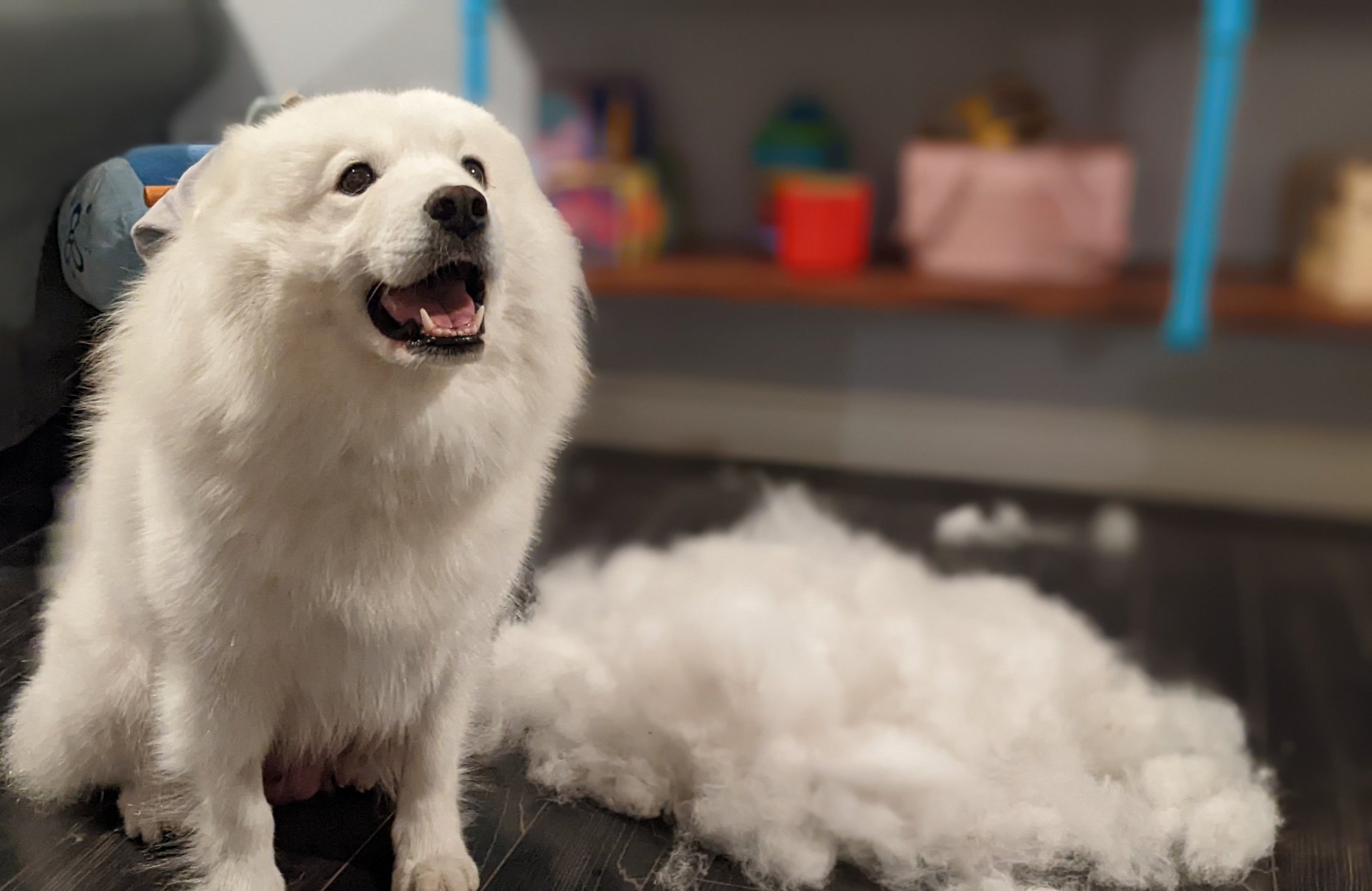
Samoyeds
There are many aspects to consider when determining if a smiling sammie is the right fit for your family.
Characteristics
Originally from Siberia, Samoyeds have a thick white coat and a fluffy plummed tail that curls on to their back. They are famous for the contrast of their black lips, eye and nose. They are dubbed “smiling sammies’ due to the subtle but definite upturned corners of their mouth. This feature is as functional as it is beautiful; it stops the samoyeds from drooling so that icicles can not form on their faces.
They are medium sized dogs; a grown male averages between 45-65lbs and 21-23” in height; a grown female averages between 35-50lbs and 19-21” in height. Males tend to have a blockier face, while females are smaller in build and bone structure. These dogs have a life expectancy of 12-14 years.
They are friendly, personable dogs that thrive with human companions. They are gentle and devoted, making them a great family pet.
Samoyeds are a jolly breed, often greeting you at the door with a bark and excitement. They are not ideal for guarding; though we have personally witnessed protective mannerisms from Sasha when other dogs approach our children.
Samoyeds are an agile, high-energy dog with great endurance and thrive with high levels of physical activity. They were traditionally bred to be working dogs, either herding reindeer or pulling sleds. In order to develop a respectful, well mannered Samoyed, it is crucial to train them thoroughly and early on.
Training Your Samoyed
Samoyeds are an intelligent breed and traditionally herding dogs. Therefore, if they are left idle, they can have a tendency to chase or nip. They are pack animals and so, it is important to establish yourself as the alpha early on, in order to have a well-behaved and reliable pet.
Ensuring that your Samoyed has sufficient social interactions, whether that be with people or other pets, can significantly impact the mental health and happiness of your pet. Samoyeds can be boisterous and destructive when bored and socially under-nourished.
Samoyeds alarm bark, a common trait when greeting a guest at the door. They can develop into nuisance barkers if they are not sufficiently worked, both mentally and physically.
A tired dog is a happy dog!
Fortunately, Samoyeds greatly thrive with human companions and are happy to participate in training of obedience, agility, herding, sledding and weight pulls. We have found success with Will Atherton Academy (previously named Fenrir), whose reasoning and methodologies are in sync with Vasilisa’s.
We highly encourage you to seek out training programs prior to inviting a Samoyed (or any breed) into your home.

Grooming
Samoyeds are famous for their thick, luxurious coats and are often expected to shed in high quantities. However, Samoyeds shedding periods are predictable, making them easy to manage. Males will blow their coats once per year, typically around their birthdays. Females will blow their coats twice per year, typically in spring and fall.
Like all Northern dogs, they have a double coat. This is the reason that Samoyeds should never be shaved/clipped. This coat not only provides insulation in cold/heat, but it provides UV protection for their skin, and may not grow back properly when damaged.
The most important aspect of Samoyed grooming care is consistant brushing. Unmanaged knots can cause pain and irritation for your dog. When a Samoyed is blowing their coat, they will need to be brushed daily. Throughout the rest of the year, 3-4 times a week is encouraged. Washing your Samoyed should be done a couple times a year and is a time consuming project. Most families pursue professional dog grooming for this service.
While the fur on a Samoyeds paws were once crucial for long periods in -40degree weather, it is now more important to trim the hair around their paw pads to limit debris getting trapped against the skin.
Unexpectedly, Samoyeds are considered hypoallergenic, since they do not drool and have very low dander levels.
Dietary Requirements
Nutrition is a huge piece of any persons health, and our canines are no different. They require the right blend of protein, fats and carboyhydrates to maintain strong muscles and bones, a healthy coat, high energy and good digestive health.
We also believe that the type of food you choose to feed your canine needs to work for your family both energetically and financially. There are many excellent options for dry kibble and wet raw food.
We encourage all pet owners to research their food to find sources that avoid fillers such as wheat, corn, soy and meat-by-products, as well as additives such as MSG, artificial dyes, sodium nitrates and added sugars. These ingredients can not only be harmful to some pets health, but are not necessary ingredients and often cheap alternatives to a superior product. Consider also the sources of these ingredients. Whenever possible, choose ethically raised grass fed or pasture raised meats and organically grown vegetables. These food sources are more often free of harmful toxins and contain a higher nutrient density.
When it comes to treats for your canines this is particularly important. It is easy to go through many treats during the puppies training stages; this is also the most important time to develop a healthy digestive system and maintain healthy body composition. Whenever possible, choose animal organs, which are low in fat and carbohydrates but high in protein, B vitamins, iron and other essential nutrients.
In our home, we choose to feed our dogs a raw homemade mixture of pasture raised chicken, wild caught fish, grass fed beef and lamb organs, pasture-raised eggs, organically grown apples, carrots, pumpkins, kale and bok choy. We are fortunate to have local resources that make this possible and understand that may not be in everyones reach, so our puppies are weaned onto a quality grain free kibble and each Vasilisa puppy goes home with a large bag, ensuring plenty of ability for transition.



